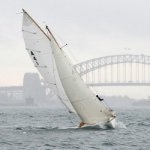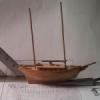Supplies of the Ship Modeler's Handbook are running out. Get your copy NOW before they are gone! Click on photo to order.
×
-
Posts
7,982 -
Joined
-
Last visited
Reputation Activity
-
 Louie da fly got a reaction from druxey in Venetian Round Ship c. 13th century by woodrat - FINISHED - 1:32 scale - fully framed
Louie da fly got a reaction from druxey in Venetian Round Ship c. 13th century by woodrat - FINISHED - 1:32 scale - fully framed
Makes sense, Dick. The narrowing of the hull gets greater in a nice smooth curve as you approach the bow and stern. Presumably the same with the rise of floors etc.
Clever.
Steven
-
 Louie da fly got a reaction from druxey in Venetian Round Ship c. 13th century by woodrat - FINISHED - 1:32 scale - fully framed
Louie da fly got a reaction from druxey in Venetian Round Ship c. 13th century by woodrat - FINISHED - 1:32 scale - fully framed
Oh yes, I knew what the words meant - just don't know the ins and outs of the technique.
Steven
-
 Louie da fly got a reaction from mtaylor in 10th-11th century Byzantine dromon by Louie da fly - FINISHED - 1:50
Louie da fly got a reaction from mtaylor in 10th-11th century Byzantine dromon by Louie da fly - FINISHED - 1:50
That's a good reason to go two-masted, Mark. Galleys in general are not too stable.
I think sail would be preferable while journeying - assuming the wind was in the right direction, so the ship wouldn't heel over too much.
Oars definitely under battle conditions - in fact the masts were lowered and stowed. For maneuvrability and also to remove overhead hazards.
Steven
-
 Louie da fly got a reaction from mtaylor in 10th-11th century Byzantine dromon by Louie da fly - FINISHED - 1:50
Louie da fly got a reaction from mtaylor in 10th-11th century Byzantine dromon by Louie da fly - FINISHED - 1:50
Mark, the single mast cE is about 2.2 metres (7 feet) taller than the double - the difference between 9.4 and 7.2 metres above the bottom of the ship - about 30% higher. Don't know how much difference that would make.
Steven
-
 Louie da fly got a reaction from Bob Legge in 10th-11th century Byzantine dromon by Louie da fly - FINISHED - 1:50
Louie da fly got a reaction from Bob Legge in 10th-11th century Byzantine dromon by Louie da fly - FINISHED - 1:50
Here are the sail plans I've arrived at - I still haven't decided to go one or two-masted, but both look better than previous versions. The dimensions no longer tie in with those of Age of the Dromon - I've decided that a gap of 200-300 years and different shipbuilding traditions, plus the different form of the two types of ship are enough to discount the Sicilian ships as a source of information. Instead, I'm going with size and placement of sail(s) to achieve the position of Centre of Effort needed to make a lateener sail properly, based on the theory outlined on the previous page of this build log.
I've also made a prototype of the Byzantine mast step assembly shown in my reconstruction diagram above. I did this in a hurry and in a poor light, so it's a bit rough. To put in the model I'll do a better job and make it complete - cutting it to width and with side pieces to hold it on the keelson.
But it seems to work!
Steven
-
 Louie da fly got a reaction from mtaylor in 10th-11th century Byzantine dromon by Louie da fly - FINISHED - 1:50
Louie da fly got a reaction from mtaylor in 10th-11th century Byzantine dromon by Louie da fly - FINISHED - 1:50
Good point, Dick. I hadn't thought of that.
Steven
-
 Louie da fly got a reaction from mtaylor in 10th-11th century Byzantine dromon by Louie da fly - FINISHED - 1:50
Louie da fly got a reaction from mtaylor in 10th-11th century Byzantine dromon by Louie da fly - FINISHED - 1:50
That makes sense, though I thought it might also affect the performance of the sail (messes with the aerofoil shape). I expect in large, state-owned ships they'd have taken the trouble to move the end of the yard to the other side of the mast whenever they tacked, as shown in the diagrams on the first page of this thread.
Sporting sailors probably don't have to worry about it so much because they don't use their boats much. However, the skipper of the caravel replica that sails around the coast in our region says he does it "the way the Arabs do" - without changing sides when he tacks. A lot less hassle, but it does have the downside of chafing.
Steven
-
 Louie da fly got a reaction from mtaylor in 10th-11th century Byzantine dromon by Louie da fly - FINISHED - 1:50
Louie da fly got a reaction from mtaylor in 10th-11th century Byzantine dromon by Louie da fly - FINISHED - 1:50
Just learnt something. I'd thought than on all lateen sails the halyard attached to the centre of the yard. Certainly a lot of them seem to be this way in contemporary pictures, but if you look at the link http://forum.woodenboat.com/showthread.php?156203-Lateen you can see lateens with what I'd have thought was a very unbalanced set-up.
Oh, and some nice footage of lateeners under sail. Having the mast to leeward of the sail (so it's blown against the mast) doesn't seem to be such a problem after all.
A pity there isn't any footage of boats sailing under lateen alone, without headsails (or booms, as some modern so-called "lateens" are).
Steven
-
 Louie da fly got a reaction from mtaylor in Venetian Round Ship c. 13th century by woodrat - FINISHED - 1:32 scale - fully framed
Louie da fly got a reaction from mtaylor in Venetian Round Ship c. 13th century by woodrat - FINISHED - 1:32 scale - fully framed
Makes sense, Dick. The narrowing of the hull gets greater in a nice smooth curve as you approach the bow and stern. Presumably the same with the rise of floors etc.
Clever.
Steven
-
 Louie da fly got a reaction from mtaylor in Venetian Round Ship c. 13th century by woodrat - FINISHED - 1:32 scale - fully framed
Louie da fly got a reaction from mtaylor in Venetian Round Ship c. 13th century by woodrat - FINISHED - 1:32 scale - fully framed
Oh yes, I knew what the words meant - just don't know the ins and outs of the technique.
Steven
-
 Louie da fly got a reaction from Mark Pearse in 10th-11th century Byzantine dromon by Louie da fly - FINISHED - 1:50
Louie da fly got a reaction from Mark Pearse in 10th-11th century Byzantine dromon by Louie da fly - FINISHED - 1:50
That's a good reason to go two-masted, Mark. Galleys in general are not too stable.
I think sail would be preferable while journeying - assuming the wind was in the right direction, so the ship wouldn't heel over too much.
Oars definitely under battle conditions - in fact the masts were lowered and stowed. For maneuvrability and also to remove overhead hazards.
Steven
-
 Louie da fly got a reaction from cog in 10th-11th century Byzantine dromon by Louie da fly - FINISHED - 1:50
Louie da fly got a reaction from cog in 10th-11th century Byzantine dromon by Louie da fly - FINISHED - 1:50
That's a good reason to go two-masted, Mark. Galleys in general are not too stable.
I think sail would be preferable while journeying - assuming the wind was in the right direction, so the ship wouldn't heel over too much.
Oars definitely under battle conditions - in fact the masts were lowered and stowed. For maneuvrability and also to remove overhead hazards.
Steven
-
 Louie da fly got a reaction from John Allen in 10th-11th century Byzantine dromon by Louie da fly - FINISHED - 1:50
Louie da fly got a reaction from John Allen in 10th-11th century Byzantine dromon by Louie da fly - FINISHED - 1:50
Here are the sail plans I've arrived at - I still haven't decided to go one or two-masted, but both look better than previous versions. The dimensions no longer tie in with those of Age of the Dromon - I've decided that a gap of 200-300 years and different shipbuilding traditions, plus the different form of the two types of ship are enough to discount the Sicilian ships as a source of information. Instead, I'm going with size and placement of sail(s) to achieve the position of Centre of Effort needed to make a lateener sail properly, based on the theory outlined on the previous page of this build log.
I've also made a prototype of the Byzantine mast step assembly shown in my reconstruction diagram above. I did this in a hurry and in a poor light, so it's a bit rough. To put in the model I'll do a better job and make it complete - cutting it to width and with side pieces to hold it on the keelson.
But it seems to work!
Steven
-
 Louie da fly got a reaction from Baker in 10th-11th century Byzantine dromon by Louie da fly - FINISHED - 1:50
Louie da fly got a reaction from Baker in 10th-11th century Byzantine dromon by Louie da fly - FINISHED - 1:50
I checked Age of the Dromon again - it does contain estimates of the yard lengths for the two lateen sails - 20.17 and 15.43 metres, based again on 75% of those of the Sicilian galleys.
I tried these against the rough drawing of the ship, putting the Centre of Effort directly above the Centre of Lateral Resistance, [edit]while keeping the mast heights the same[/edit].
Note that the shape which produces the most power for a given length of yard is a 90-45-45 degree triangle, but these yards are at 32 and 37 degrees [edit] due to the height of the masts. Higher masts would enable a greater angle. [/edit]
However, although modern lateeners certainly sail with the yard at 45 degrees
they also quite commonly have the yard at a lower angle,
so perhaps this is correct. (Note, by the way, that the above picture shows that the mariners haven't bothered to move the bottom end of the yard to the other side of the mast when they tacked - the sails are being blown against the masts).
Certainly you come across a lot of renaissance pictures of lateen-rigged galleys with low angled yards - mostly furled . . .
but sometimes also under sail.
And the mediaeval pictures also often have yards at a lower angle than 45 degrees (see the posts above).
So I'll go with this and see how it works. However, it occurs to me that the Sicilian galleys didn't have a forecastle or central castles as the dromon does, so I'd be justified in having higher masts, which could perhaps have the 90-45-45 triangle after all.
I also worked up a drawing of the dromon with a single mast, showing the Centre of Effort directly above the Centre of Lateral Resistance. It looks good too, though the CE is considerably higher than on the two-masted version. [edit] The mast is higher on this one than the lengths shown in the book. [/edit]
Steven
-
 Louie da fly got a reaction from mtaylor in 10th-11th century Byzantine dromon by Louie da fly - FINISHED - 1:50
Louie da fly got a reaction from mtaylor in 10th-11th century Byzantine dromon by Louie da fly - FINISHED - 1:50
Here are the sail plans I've arrived at - I still haven't decided to go one or two-masted, but both look better than previous versions. The dimensions no longer tie in with those of Age of the Dromon - I've decided that a gap of 200-300 years and different shipbuilding traditions, plus the different form of the two types of ship are enough to discount the Sicilian ships as a source of information. Instead, I'm going with size and placement of sail(s) to achieve the position of Centre of Effort needed to make a lateener sail properly, based on the theory outlined on the previous page of this build log.
I've also made a prototype of the Byzantine mast step assembly shown in my reconstruction diagram above. I did this in a hurry and in a poor light, so it's a bit rough. To put in the model I'll do a better job and make it complete - cutting it to width and with side pieces to hold it on the keelson.
But it seems to work!
Steven
-
 Louie da fly got a reaction from cog in Venetian Round Ship c. 13th century by woodrat - FINISHED - 1:32 scale - fully framed
Louie da fly got a reaction from cog in Venetian Round Ship c. 13th century by woodrat - FINISHED - 1:32 scale - fully framed
Makes sense, Dick. The narrowing of the hull gets greater in a nice smooth curve as you approach the bow and stern. Presumably the same with the rise of floors etc.
Clever.
Steven
-
 Louie da fly got a reaction from cog in Venetian Round Ship c. 13th century by woodrat - FINISHED - 1:32 scale - fully framed
Louie da fly got a reaction from cog in Venetian Round Ship c. 13th century by woodrat - FINISHED - 1:32 scale - fully framed
Oh yes, I knew what the words meant - just don't know the ins and outs of the technique.
Steven
-
 Louie da fly got a reaction from cog in 10th-11th century Byzantine dromon by Louie da fly - FINISHED - 1:50
Louie da fly got a reaction from cog in 10th-11th century Byzantine dromon by Louie da fly - FINISHED - 1:50
Here are the sail plans I've arrived at - I still haven't decided to go one or two-masted, but both look better than previous versions. The dimensions no longer tie in with those of Age of the Dromon - I've decided that a gap of 200-300 years and different shipbuilding traditions, plus the different form of the two types of ship are enough to discount the Sicilian ships as a source of information. Instead, I'm going with size and placement of sail(s) to achieve the position of Centre of Effort needed to make a lateener sail properly, based on the theory outlined on the previous page of this build log.
I've also made a prototype of the Byzantine mast step assembly shown in my reconstruction diagram above. I did this in a hurry and in a poor light, so it's a bit rough. To put in the model I'll do a better job and make it complete - cutting it to width and with side pieces to hold it on the keelson.
But it seems to work!
Steven
-
 Louie da fly got a reaction from druxey in 10th-11th century Byzantine dromon by Louie da fly - FINISHED - 1:50
Louie da fly got a reaction from druxey in 10th-11th century Byzantine dromon by Louie da fly - FINISHED - 1:50
Here are the sail plans I've arrived at - I still haven't decided to go one or two-masted, but both look better than previous versions. The dimensions no longer tie in with those of Age of the Dromon - I've decided that a gap of 200-300 years and different shipbuilding traditions, plus the different form of the two types of ship are enough to discount the Sicilian ships as a source of information. Instead, I'm going with size and placement of sail(s) to achieve the position of Centre of Effort needed to make a lateener sail properly, based on the theory outlined on the previous page of this build log.
I've also made a prototype of the Byzantine mast step assembly shown in my reconstruction diagram above. I did this in a hurry and in a poor light, so it's a bit rough. To put in the model I'll do a better job and make it complete - cutting it to width and with side pieces to hold it on the keelson.
But it seems to work!
Steven
-
 Louie da fly got a reaction from Landrotten Highlander in 10th-11th century Byzantine dromon by Louie da fly - FINISHED - 1:50
Louie da fly got a reaction from Landrotten Highlander in 10th-11th century Byzantine dromon by Louie da fly - FINISHED - 1:50
Here are the sail plans I've arrived at - I still haven't decided to go one or two-masted, but both look better than previous versions. The dimensions no longer tie in with those of Age of the Dromon - I've decided that a gap of 200-300 years and different shipbuilding traditions, plus the different form of the two types of ship are enough to discount the Sicilian ships as a source of information. Instead, I'm going with size and placement of sail(s) to achieve the position of Centre of Effort needed to make a lateener sail properly, based on the theory outlined on the previous page of this build log.
I've also made a prototype of the Byzantine mast step assembly shown in my reconstruction diagram above. I did this in a hurry and in a poor light, so it's a bit rough. To put in the model I'll do a better job and make it complete - cutting it to width and with side pieces to hold it on the keelson.
But it seems to work!
Steven
-
 Louie da fly reacted to Baker in Golden Hind (ex-Pelican) by Baker - FINISHED - scale 1/45 - Galleon late 16th century
Louie da fly reacted to Baker in Golden Hind (ex-Pelican) by Baker - FINISHED - scale 1/45 - Galleon late 16th century
Hello everyone,
The gun carriages. These are under deck and will not remain fully visible, only minor details will be added.
First the sides are made with the electric crosscut saw. And then the bottom pieces are made with the same saw.
My method uses a lot of wood in relation to what is needed. I used softwood for this.
To know the dimensions a drawing has been made before i started.
The bottom piece is multi-functional so that long or short, narrow or wide, carriages can be made from the same pieces.
Making the wheels (the Backer way). Thin slices of wood are sawn and from these slices the wheels are "knocked out". After this I just do some sanding and make a hole in the middle.
work in progress
A first test
Thanks for following.
-
 Louie da fly got a reaction from Mark Pearse in 10th-11th century Byzantine dromon by Louie da fly - FINISHED - 1:50
Louie da fly got a reaction from Mark Pearse in 10th-11th century Byzantine dromon by Louie da fly - FINISHED - 1:50
That makes sense, though I thought it might also affect the performance of the sail (messes with the aerofoil shape). I expect in large, state-owned ships they'd have taken the trouble to move the end of the yard to the other side of the mast whenever they tacked, as shown in the diagrams on the first page of this thread.
Sporting sailors probably don't have to worry about it so much because they don't use their boats much. However, the skipper of the caravel replica that sails around the coast in our region says he does it "the way the Arabs do" - without changing sides when he tacks. A lot less hassle, but it does have the downside of chafing.
Steven
-
 Louie da fly got a reaction from mtaylor in 10th-11th century Byzantine dromon by Louie da fly - FINISHED - 1:50
Louie da fly got a reaction from mtaylor in 10th-11th century Byzantine dromon by Louie da fly - FINISHED - 1:50
Very interesting, Carl. I haven't come across this one before. Certainly lateen rigged, and the "wings" at the stern are thought to hold a crosspiece which supports the yard when it's not in use. The hull is very unusual.
I wonder where they got the design from? It doesn't look like anything I've seen in contemporary pictures. But there's plenty of stuff out there I've never seen.
Steven
-
 Louie da fly got a reaction from mtaylor in Hanseatic Ship c. 1500 by goetzi73 - 1:50 - first scratch build
Louie da fly got a reaction from mtaylor in Hanseatic Ship c. 1500 by goetzi73 - 1:50 - first scratch build
Nice work, Goetzi. Coming together well.
Yes, almost all the forecastles I've seen in contemporary representations from this period seem to come to a sharp point at the bow - at least the ones that can be seen, whether they be from the Mediterranean or northern Europe in the region including the Hanse ports.
Steven
-
 Louie da fly got a reaction from cog in 10th-11th century Byzantine dromon by Louie da fly - FINISHED - 1:50
Louie da fly got a reaction from cog in 10th-11th century Byzantine dromon by Louie da fly - FINISHED - 1:50
Very interesting, Carl. I haven't come across this one before. Certainly lateen rigged, and the "wings" at the stern are thought to hold a crosspiece which supports the yard when it's not in use. The hull is very unusual.
I wonder where they got the design from? It doesn't look like anything I've seen in contemporary pictures. But there's plenty of stuff out there I've never seen.
Steven








